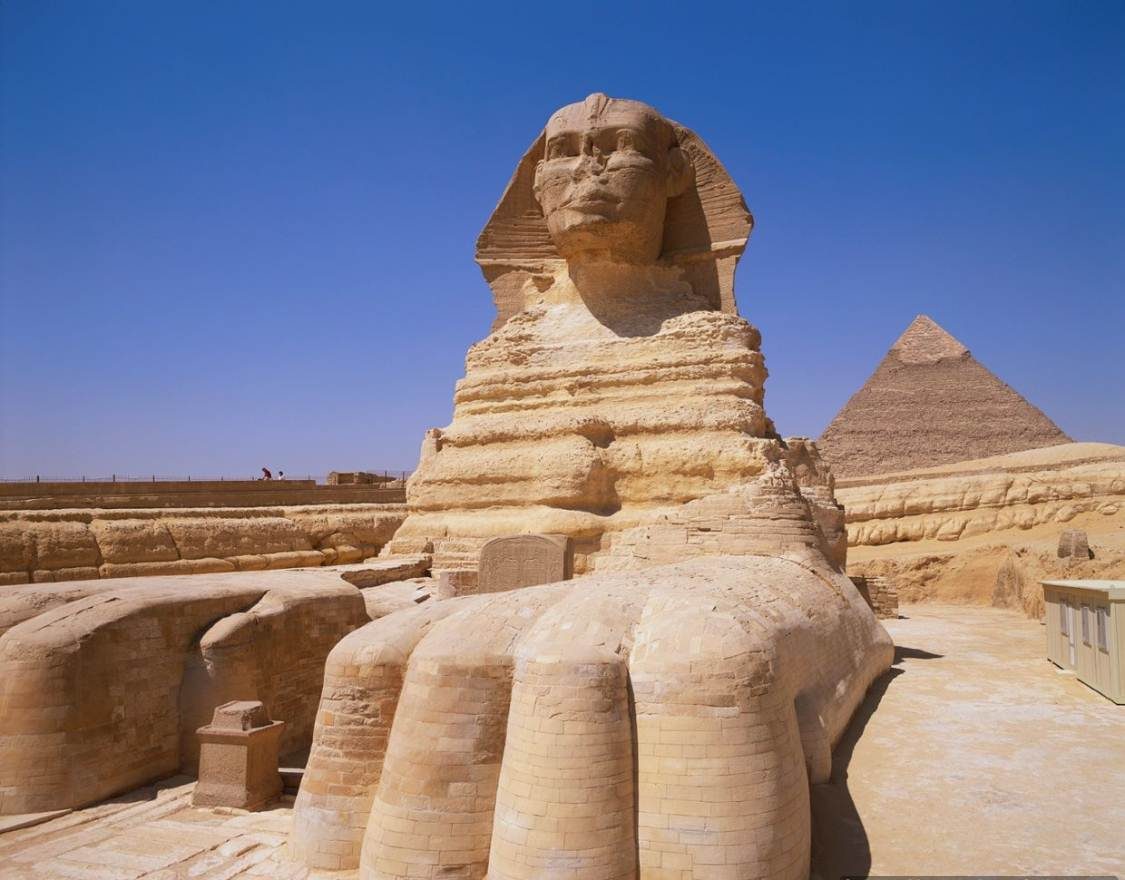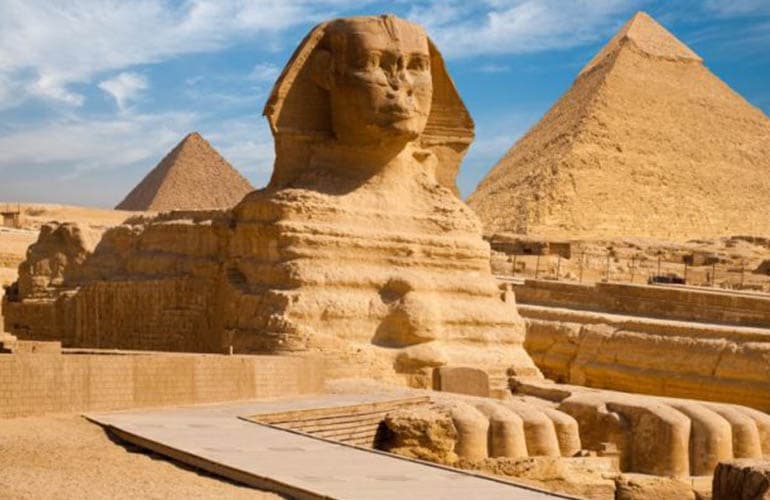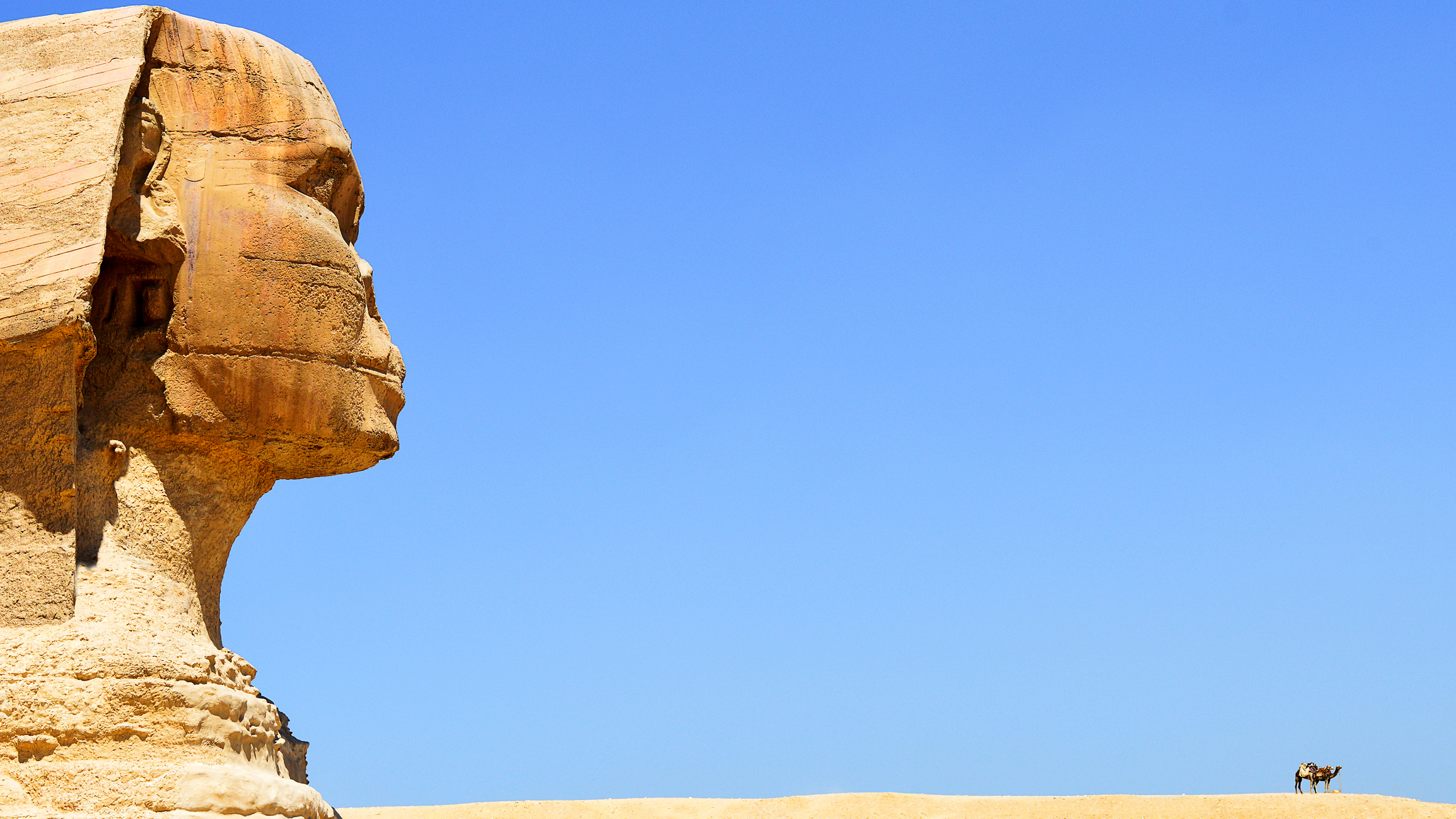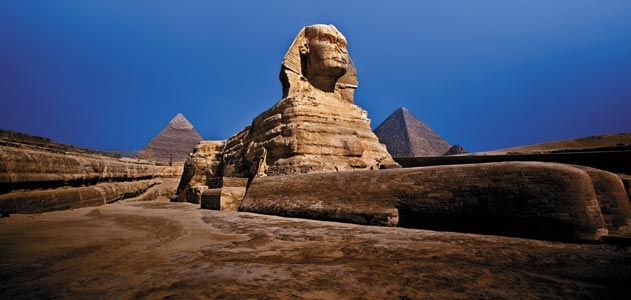The Great Sphinx of Giza: A Timeless Symbol of Egypt
As the most recognizable landmark in Egypt and an iconic symbol of its rich history, the Great Sphinx of Giza is a timeless marvel that has captivated people's imaginations worldwide. Nestled amidst the towering pyramids of Giza and surrounded by the mystique of ancient Egyptian civilization, the Sphinx has stood tall for over 4,500 years as an embodiment of the country's strength, power, and resilience. From its immense size to the intricate details etched onto its weathered surface, the Great Sphinx is a fascinating example of the enduring legacy of one of the world's oldest cultures. Join me as we uncover the mysteries and marvels of this mystical monument and delve deep into the history behind its allure.

Introduction to The Great Sphinx of Giza
Hey there, traveller! Have you ever heard of the Great Sphinx of Giza? It's a statue unlike any other, standing proud and tall on the west bank of the Nile River in Egypt. With a lion's body and a human's head adorned with a royal headdress, the Great Sphinx is one of Egypt's most famous landmarks and arguably the best-known example of sphinx art. It measures 240 feet long and 66 feet high, making it among the world's largest sculptures.
The Great Sphinx is believed to date back to the reign of King Khafre, who ruled during the fourth dynasty. Most scholars agree that he was likely the one who commissioned the statue. However, some people argue that the statue was built by Khafre's older brother, Djedefre, who dedicated it to their father. These theorists claim that the Great Sphinx resembles Khufu, their father, more than Khafre.
Over the years, the Great Sphinx has been subject to various preservation efforts to prevent further deterioration. It has greatly deteriorated since ancient times. The body has suffered the most damage, and the face has been damaged, with the nose missing. Some believe this damage was caused by Napoleon's troops, who shot off the nose with a cannon. However, illustrations predating Napoleon's birth reveal a noseless Sphinx. Another theory suggests that Muhammad Saʾim al-Dahr, a Sufi Muslim, mutilated the statue in the 14th century to protest against the pharaoh.
Despite its damaged face and body, the Great Sphinx remains an important historical symbol and a significant tourist attraction, attracting thousands of visitors every year worldwide. It has endured for thousands of years, withstanding the test of time and reminding us of Egypt's rich history and culture. So, if you ever visit Egypt, stop by the Great Sphinx and witness this timeless masterpiece with your own eyes. [1][2]

Description and Characteristics of The Great Sphinx
The Great Sphinx of Giza is an awe-inspiring statue on the Nile River's west bank in Egypt. This majestic statue is made from a single piece of limestone and measures 240 feet long and 66 feet high, making it one of the largest sculptures in the world. The Great Sphinx has the body of a lion and a human head adorned with a royal headdress. The face of the statue is said to represent the Pharaoh Khafre, who is believed to have commissioned its construction in the 4th dynasty around 2500 BC.
Scholars estimate that the statue was crafted by 100 workers using stone hammers and copper chisels, and it would have taken about three years to complete. The Great Sphinx's distinctive features, including its size and symbolic representation, make it essential to Egypt's rich history and cultural heritage.
The Great Sphinx's face has been the subject of much speculation and debate. It is widely believed to represent Khafre, but some theories suggest that it may be an image of his father or older brother. The statue has endured thousands of years, but over time, it has deteriorated due to natural and human factors. In ancient times, various efforts were undertaken to preserve the statue, but it wasn't until modern times that significant strides were made to ensure its continued survival.
The Sphinx has also sustained significant damage to its nose, which has long been a topic of controversy and myth. It is uncertain when and why the nose was broken, but various myths surround this infamous event. Some believe that Napoleon's troops shot it off, while others think a Muslim extremist destroyed it. Both theories remain highly unlikely, as the Sphinx's nose had been missing for centuries before Napoleon arrived in Egypt. Studies have shown that the nose was intentionally broken, but why remains unclear.
Today, the Great Sphinx remains a celebrated symbol of ancient Egypt, attracting visitors worldwide. It is a testament to the incredible skill and artistry of the ancient Egyptians and an enduring symbol of their cultural and historical legacy. Despite the ongoing challenges of preservation, the Great Sphinx continues to command awe and admiration, inviting us to contemplate the mysteries of the ancient world and the rich history of Egypt. [3][4]

Historical Significance of The Great Sphinx
Are you ready to learn about the historical significance behind the Great Sphinx of Giza? This incredible statue is one of Egypt's most famous landmarks and is arguably the best-known example of sphinx art. Standing at 66 feet (20 meters) high and 240 feet (73 meters) long, it's among the world's largest sculptures. The Great Sphinx features a body and a human head adorned with a royal headdress. It is believed to have been carved from a single piece of limestone, with pigment residue suggesting that it was painted in its entirety. According to some estimates, it would have taken about three years for 100 workers using stone hammers and copper chisels to finish the statue.
Most scholars date the Great Sphinx to the 4th dynasty and attribute ownership to King Khafre. However, some believe that it was built by Khafre's older brother, Djedefre, to their father, whose pyramid at Giza is known as the Great Pyramid. These theorists claim that the face of the Great Sphinx bears more resemblance to Khufu than Khafre, and that observation also led to speculation that Khufu built the statue.
Over the years, the Great Sphinx has greatly deteriorated, and since ancient times, possibly beginning in the reign of Thutmose IV, various efforts have been undertaken to preserve the statue. Although the body has suffered the most, the face has also been damaged, and its nose is missing. According to some, the damage was caused by Napoleon's troops, who shot off the nose with a cannon. However, illustrations that date before Napoleon reveal a noseless sphinx. Another theory suggests that Muhammad Saʾim al-Dahr, a Sufi Muslim, mutilated the statue in the 14th century to protest against the perceived idol worship of the Egyptian people.
Despite its damaged state, the Great Sphinx of Giza remains a timeless symbol of Egypt, giving us a glimpse into the country's fascinating ancient history. Nowadays, the preservation efforts for the monument continue to be a top priority. As visitors from all around the world come to marvel at this impressive piece of history, we must do our part to ensure its continued existence for future generations to enjoy. [5][6]

Theories About The Great Sphinx's Origin and Ownership
Are you fascinated by the mysteries surrounding the Great Sphinx of Giza? Let’s explore some theories about the origin and ownership of this massive statue, which has captivated travellers and archaeologists for centuries!
1. Khafre built the Great Sphinx
Most scholars believe that Pharaoh Khafre (about 2603-2578 BC) built the Great Sphinx as part of his pyramid complex in Giza. The statue is made of a single block of limestone and measures a staggering 240 feet (73 meters) long and 66 feet (20 meters) tall. Khafre is also known for building the second-largest pyramid in Giza, just a stone’s throw away from the Great Sphinx.
2. Djedefre built the Great Sphinx
However, some argue that Khafre's older brother Djedefre built the Great Sphinx to honour their father, Pharaoh Khufu. The Great Sphinx’s face closely resembles Khufu, leading some to speculate that he commissioned the statue.
3. The Great Sphinx was painted
Scientists have found traces of red pigment on the Great Sphinx's face, suggesting the statue was once painted. This was a common practice in ancient Egyptian art, as it added vibrant colours to the often-drab limestone statues. The paint has since been eroded by weather and time, leaving the Great Sphinx with its iconic limestone hue.
4. Invaders damaged the Great Sphinx
The Great Sphinx has suffered damage over the centuries, particularly to its face. While some blame Napoleon’s troops for the destruction, illustrations of the statue from before Napoleon's time already show the Great Sphinx without a nose. Another theory posits that a Sufi Muslim named Muhammad Saʾim al-Dahr mutilated the statue in the 14th century to protest idolatry.
5. The Great Sphinx may have had a celestial purpose
Some scholars speculate that the Great Sphinx and its accompanying temple complex had a celestial purpose beyond honouring a pharaoh. They believe that the Sphinx aligned with the sun on the spring equinox, representing the rebirth of the pharaoh's soul. The temple complex also included a causeway that linked the Sphinx to Khafre's pyramid, suggesting a spiritual journey to the pharaoh's final resting place.
6. Preservation efforts for the Great Sphinx
Despite its impressive size and ancient history, the Great Sphinx has required significant efforts to preserve it for future generations. Conservationists have worked to stabilize the statue’s cresting, repair damage to the body, and protect it from erosion and pollution. This includes filling in cracks with resin, applying salt water to the limestone to harden it, and using microorganisms to clean away dirt and debris.
The Great Sphinx may remain shrouded in mystery, but one thing is certain: it embodies the timeless spirit of ancient Egypt and continues to inspire awe in visitors today. [7][8]

Preservation Efforts for The Great Sphinx
Are you a history buff? Do you love immersing yourself in the mysteries of ancient civilizations? If so, then you probably already know about the Great Sphinx of Giza. This imposing statue, which is an impressive 240 feet long and 66 feet high, is one of Egypt's most famous landmarks and arguably the best-known example of sphinx art. Carved from a single piece of limestone, pigment residue suggests that the entire Great Sphinx was painted. According to some estimates, it would have taken about three years for 100 workers to finish the statue using stone hammers and copper chisels.
However, this timeless symbol of Egypt has greatly deteriorated over the years, and since ancient times - possibly beginning in the reign of Thutmose IV - various efforts have been undertaken to preserve the statue. While the body has suffered the most, the face has also been damaged, with its nose missing. There are various theories on how this damage was caused, from Napoleon's troops shooting off the nose with a cannon to a Sufi Muslim mutilating the statue in the 14th century to protest idolatry.
Despite the statue's age and deterioration, preservation efforts are ongoing to ensure that this piece of history endures for future generations to admire and study. The First International Symposium on the Great Sphinx was convened in 1992, with 90 invited Egyptian and foreign experts from various disciplines to provide a forum for objective assessments of offered methodologies and to facilitate the exchange of information. The conference considered site management approaches for the entire Giza Plateau, a World Heritage Site southwest of Cairo. The Plateau is the location of the Sphinx and the well-known pyramids of Cheops, Chephren, and Mycerinus.
Since the conference, preservation efforts have appeared to have improved. Mark Lehner of the Oriental Institute of the University of Chicago has documented the Sphinx since 1979. Dr Lehner presented his results and noted that the architectural records of the Sphinx make it possible to construct a computer model of the current condition of the monument and its hypothesized condition during ancient times. Lehner believes that additional refinements to the model will be useful in future conservation studies. Additionally, the limestone used in the construction of the Sphinx varies in durability. While the stone for the head and base is relatively hard, soft layers of limestone alternate with harder limestone in the body portion in between. It is here that the most serious deterioration can be seen. To address this, preventive conservation measures have been proposed.
The Great Sphinx of Giza remains a captivating symbol of Egyptian civilization, and preservation efforts continue to ensure that it remains so for future generations. While the statue has endured significant wear and tear, many people today are committed to preserving it for the education and enjoyment of people worldwide. [9][10]
